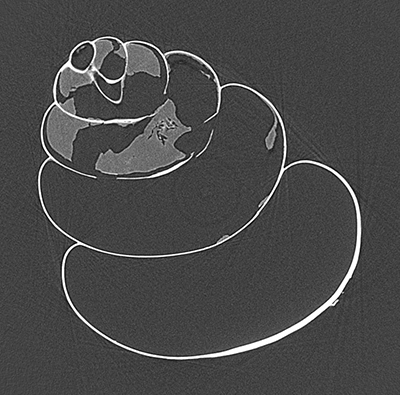 Investigating CT Scans as a Palaeontology Research Tool
Investigating CT Scans as a Palaeontology Research Tool
You are probably familiar with a computed tomography (CT) scan; that medical machine that takes a bunch of x-ray scans of a person’s internal anatomy. If you haven’t had a CT scan yourself, you most likely know someone who has. CT scans are a great non-invasive technique that can be used to diagnose internal injuries and disease. What you may not know, is that CT scans can also be useful to look at structures of fossils.
Dr. Rosie Oakes and her colleagues recently published an article in Palaeontologia Electronica on how CT scans can best be used for palaeontology research. “If you want to see inside an object but you don’t want to (or aren’t allowed to) smash it with a hammer, you can use a CT scanner” says Dr. Oakes.
All sorts of objects can be analyzed internally with a CT scanner as long as they fit inside the machine. As far as fossils go, that includes everything from “tiny microfossils like foraminifera and pteropods, to dinosaur bones and mammoth teeth!” Dr. Oakes exclaims.
But how exactly does this work for organisms that no longer have flesh or internal organs? Morgan Hill Chase, an author on the paper, explains, “An industrial computed tomography, or CT scanner works much like a medical CT scanner: hundreds of x-rays are taken from 360° around the object of interest. These x-rays are then compiled to make a 3D model of the object that can be digitally sliced through to look at internal and external features of that object.” Check out the video below to see this in action!
 Click on image to run or download animation. (Or you can follow this link: YouTube)
Click on image to run or download animation. (Or you can follow this link: YouTube)
However, there are some difficulties when observing fossils still surrounded by a rock matrix. “It is difficult to digitally separate fossils from the rock matrix if they are the same density. This can happen if the shell or bone is similar to the surrounding matrix, such as carbonate shells within a limestone, or when a mineral has been replaced during diagenesis” states Dr. Jocelyn Sessa, one of the papers authors. In this case, essentially the fossil and rock will look like the same mass and the fossil itself will be difficult to distinguish.
Other obstacles to CT scan facilitated research are time and cost. As discussed in this article, costs range into the hundreds of dollars per hour of scanning time. Sessions are also booked months in advance due to high demand, leaving no room for last minute catastrophes or delays.
“For us, having short windows of time to collect the data definitely slowed down data collection, however, it also enabled us to analyze our data in stages meaning we could refine our research questions as we went along” says Dr. Oakes.
“Lots of methods in science are expensive, time consuming, and require forward planning. In our research with pteropods (a group of small swimming snails), we found that CT scans will be an important tool for monitoring such ecologically important groups as the global climate continues to change. In our opinion, the planning involved to collect this data was absolutely worth it!” shares Dr. Sessa.
Their research also tested a common misconception regarding CT scans; that the longer you scan an object produces a higher quality scan. “We found that a longer scan time doesn’t necessarily produce a better-quality scan” says Dr. Oakes.
So far, their results suggest a sweet spot scanning time of about 50 minutes.
“Our study highlights the importance of conducting some repeat scans to find the sweet spot between scan quality and scan time when establishing a new scanning method so that precious time and research money can be used more effectively” states Dr. Oakes.
CT scans have become an important research tool, especially because they don’t require damaging a specimen. “Digital scans can then be shared with scientists and members of the public from around the world for research and education purposes” adds Morgan Hill Chase.
In conclusion, scan time is an important factor to consider for CT research. “By limiting scan time to 50 minutes, scientists can either scan more specimens in the same amount of time, or spend less money to collect the data they need. This efficient use of CT time should enable more research to be conducted using this valued instrument” says Dr. Oakes.
A huge thank you to all authors, Rosie Oakes, Morgan Hill Chase, Mark Siddall, and Jocelyn Sessa for their contributions!
You can check out the original article here!

